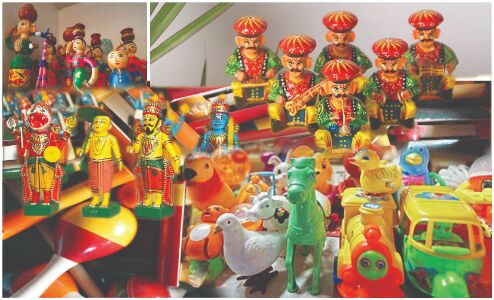A global future
India’s diverse collective of regional toys — coupled with robust manufacturing potential and renewed push from governments — lends it a competitive edge over many countries; asserts Aarushi Aggarwal

Childhood games, tangible or invented, are crucial for a child's cognitive development and early socialisation. They allow children to think outside the box — stoking their creativity and imaginative capabilities. It is, therefore, no surprise (and is indeed a welcome move) that the New Education Policy, 2019 lays primary emphasis on toys for children. Prime Minister Modi has also emphasised the significance of toys in his signature radio show Mann Ki Baat while spearheading a push to manufacturing more toys domestically.
A renewed focus
Nearly every state and region of India can boast of its own indigenous toys that have been perfected over generations. They typically capitalise on the region's advantage — whether that lay in rich textiles, intricate woodwork or elaborate traditional pottery. In addition to being extrapolated to modern toys, this inherent capacity of India's various local economies has the potential to be expanded onto a nation-wide scale that can catapult India to a leading global manufacturer and exporter of toys. Recognising this potential, the Central Government, in consultation with 14 Union ministries, has prepared a 17-point National Action Plan for Toys that will include need-based interventions for the development of the toys sector in 13 identified handicraft toy clusters.
The action plan also includes provisions to make public procurement of indigenous toys, promote 'Make in India' and indigenous toy clusters, drive consumer awareness campaigns, implement quality control, and foster investments in the industry. Under this action plan, the Textiles Ministry has also proposed a National Toy Fair to be held between February 27 and March 2, 2021.
The 'India' advantage
The estimated value of the Indian toy industry is around USD one billion. This presents tremendous manufacturing opportunities for both local and global players. The widespread availability of raw materials (plastics, paperboards and textiles available at competitive prices; India is the second-largest producer of polyester and related fibres) plays to the industry's advantages by nullifying the need for imports and, therefore, reducing manufacturing costs. This is crucial for the 4,000 manufacturers in the sector — 75 per cent of whom are micro units and 22 per cent are small and medium enterprises.
Second, the large number of manufacturers is testimony to India's widespread web of technical know-how to manufacture toys on a large scale. The in-built diversity within the sector underscores India's capacity to become a viable alternative source for the global toy demand.
Finally, various market variables signify India's enhanced market suitability as a manufacturing destination. India offers a huge skilled labour force at a cheaper rate as compared to competing manufacturing countries in the region. With the projected population of 1.4 billion by 2025, India will also soon become the single largest integrated market within one set of national borders — a fact of immense importance to manufacturers looking to scale production and monetise quickly with ease.
Domestic potential
As domestic manufacturers rushed to fulfil the increased demand, allied sectors too were jumpstarted to provide necessary raw materials and automation equipments. Thus, to support existing and new players in the sector, state governments have established, or are establishing, toy clusters with plug and play facilities, easy raw materials and port access, and the necessary testing labs.
In terms of exports, Maharashtra is leading with 32.6 per cent of India's toy export share, followed by Uttar Pradesh and Karnataka, with 19.3 and 13.6 per cent respectively. Other emerging states in the sector include Tamil Nadu, Gujarat, Telangana, and Andhra Pradesh. These clusters will cater both to traditional and modern toys, with a near equal distribution of resources and funds. Critically, these state governments are offering up to 30 per cent in capital investment subsidy — a lucrative incentive for all producers.
The increasing focus on digitising India holds promises for the toy industry. An integrated digital platform can increase knowledge of, and access to multiple indigenous toy clusters. This increase in demand will support thousands of traditional handicraft artisans on whom the traditional toys industry rests. Much like toys support early childhood development, the toy industry supports many economic aspects of the country. This integrated approach to the industry's localisation can truly manifest India's 'atmanirbharta'.
The writer is a researcher at Invest India. Views expressed are personal



